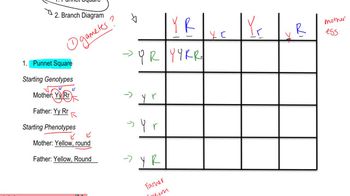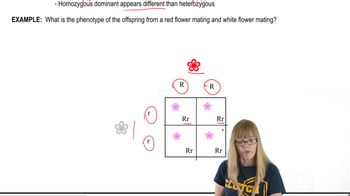Table of contents
- 1. Introduction to Genetics51m
- 2. Mendel's Laws of Inheritance3h 37m
- 3. Extensions to Mendelian Inheritance2h 41m
- 4. Genetic Mapping and Linkage2h 28m
- 5. Genetics of Bacteria and Viruses1h 21m
- 6. Chromosomal Variation1h 48m
- 7. DNA and Chromosome Structure56m
- 8. DNA Replication1h 10m
- 9. Mitosis and Meiosis1h 34m
- 10. Transcription1h 0m
- 11. Translation58m
- 12. Gene Regulation in Prokaryotes1h 19m
- 13. Gene Regulation in Eukaryotes44m
- 14. Genetic Control of Development44m
- 15. Genomes and Genomics1h 50m
- 16. Transposable Elements47m
- 17. Mutation, Repair, and Recombination1h 6m
- 18. Molecular Genetic Tools19m
- 19. Cancer Genetics29m
- 20. Quantitative Genetics1h 26m
- 21. Population Genetics50m
- 22. Evolutionary Genetics29m
3. Extensions to Mendelian Inheritance
Variations of Dominance
Problem 8d
Textbook Question
Two genes interact to produce various phenotypic ratios among F₂ progeny of a dihybrid cross. Design a different pathway explaining each of the F₂ ratios below, using hypothetical genes R and T and assuming that the dominant allele at each locus catalyzes a different reaction or performs an action leading to pigment production. The recessive allele at each locus is null (loss-of-function). Begin each pathway with a colorless precursor that produces a white or albino phenotype if it is unmodified. The ratios are for F₂ progeny produced by crossing wild-type F₁ organisms with the genotype RrTt.
9/16 red : 7/16 white
 Verified step by step guidance
Verified step by step guidance1
<span>Step 1: Identify the genotypes that contribute to the phenotypic ratio. In a dihybrid cross of RrTt x RrTt, the F₂ generation will have a 9:3:3:1 genotypic ratio. However, we need to explain a 9:16 red : 7:16 white phenotypic ratio.</span>
<span>Step 2: Determine the role of each gene. Assume that the dominant allele R catalyzes the first step in the pathway, converting a colorless precursor to an intermediate. The dominant allele T catalyzes the second step, converting the intermediate to a red pigment.</span>
<span>Step 3: Define the phenotypes based on genotypes. The red phenotype (9/16) occurs when both R and T are present and functional (R_T_). The white phenotype (7/16) occurs when either or both steps are blocked, i.e., when the genotype is rrT_, R_tt, or rrtt.</span>
<span>Step 4: Explain the genetic interaction. This is an example of complementary gene action, where both genes are required for the final product (red pigment) to be produced. If either gene is homozygous recessive, the pathway is blocked, resulting in a white phenotype.</span>
<span>Step 5: Summarize the pathway. The pathway starts with a colorless precursor. The presence of at least one dominant R allele allows conversion to an intermediate. The presence of at least one dominant T allele allows conversion of the intermediate to a red pigment. If either step is blocked by recessive alleles, the result is a white phenotype.</span>
Recommended similar problem, with video answer:
 Verified Solution
Verified SolutionThis video solution was recommended by our tutors as helpful for the problem above
Video duration:
2mPlay a video:
Was this helpful?
Key Concepts
Here are the essential concepts you must grasp in order to answer the question correctly.
Dihybrid Cross
A dihybrid cross involves two traits, each controlled by different genes, typically represented by two pairs of alleles. In this scenario, the genes R and T are being studied, where each gene can have a dominant or recessive allele. The F₂ progeny ratios arise from the combination of these alleles during gamete formation and fertilization, illustrating Mendelian inheritance patterns.
Recommended video:
Guided course

Punnet Square
Phenotypic Ratios
Phenotypic ratios represent the relative frequencies of different phenotypes in the offspring resulting from a genetic cross. In this case, the 9:7 ratio indicates that certain combinations of dominant alleles lead to red pigment production, while others result in a white or albino phenotype. Understanding how these ratios arise from gene interactions is crucial for explaining the observed outcomes in the F₂ generation.
Recommended video:
Guided course

Mutations and Phenotypes
Gene Interaction
Gene interaction occurs when the effects of one gene are modified by one or more other genes, leading to a combined effect on the phenotype. In this question, the dominant alleles of genes R and T catalyze different reactions that contribute to pigment production. The recessive alleles are loss-of-function, meaning they do not produce a functional product, which can significantly alter the resulting phenotypic ratios in the progeny.
Recommended video:
Guided course

Interacting Genes Overview

 4:37m
4:37mWatch next
Master Variations on Dominance with a bite sized video explanation from Kylia Goodner
Start learningRelated Videos
Related Practice


